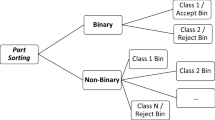Abstract
This paper is the second part of a two-part article, which presents an adaptable automated visual inspection scheme (A2VIS) and its implementations. With the proposed A2VIS, the machine vision system can be deployed to undertake new inspection tasks and adapt to new operation conditions without excessive offline training efforts. In part I, the proposed A2VIS is described as a generic scheme at a conceptual level, with respect to the system components and structure, operating procedure, and performance measures. In part II, we focus on implementation details of A2VIS. For subject localization, an efficient edge-based template matching method is developed to allow tolerance against image distortion due to rotation and changes in size and position. Upon identifying the region of interest (ROI), image features are extracted through principal component analysis (PCA). Based on the extracted features, support vector machine (SVM) technique is employed to construct a reliable classification model. During model adaptation phase, online learning is used to build both the feature model and classification model for the purpose of performing inspection during the system training period. In the system evaluation with respect to the system efficiency and inspection accuracy, data collected from an automobile parts assembly inspection cell are used to assist system implementation and verify the fulfillment of design goals.
Similar content being viewed by others
References
Goh T (1996) Simulated annealing optimization in Chamfer matching. Proc SPIE 2904:49–56
Dao MS, Natale D, Massa FGB, Graphitech AT (2007) Edge potential functions (EPF) and genetic algorithms (GA) for edge-based matching of visual objects. IEEE Trans Multimed 9(1):120–135
Lowe DG (1999) Object recognition from local scale-invariant features. Proc Int Conf Comput Vision 2:1150–1157
Canny J (1986) A computational approach to edge detection. IEEE Trans Patt Anal Mach Intell 8(6):679–698
Rosenfeld A, Pfaltz JL (1966) Sequential operations in digital picture processing. J ACM 13(4):471–494
Barker JR (1997) Algorithms for image processing and computer vision. Wiley, New York
Tretter D, Bounman CA, Khawaja KW, Maciejewski AA (1995) A multiscale stochastic image model for automated inspection. IEEE Trans Image Process 4(12):1641–1654
Killing J, Surgenor BW, Mechefske CK (2009) A machine vision system for the detection of missing fasteners on steel stampings. Int J Adv Manuf Technol 41(7–8):808–819
Sun J, Sun Q, Surgenor BW (2012) Adaptable automated visual inspection scheme using online learning. Int J Adv Manuf Technol 59(5–8):655–667
Turk M, Pentland A (1991) Eigenface for recognition. J Cogn Neurosci 3(1):71–86
Jensen DR, Solomon H (1972) A Gaussian approximation for the distribution of definite quadratic forms. J Am Stat Assoc 67:898–902
Jackson JE, Mudholkar GS (1979) Control procedures for residuals associated with principle component analysis. Technometrics 21(3):341–349
Vapnik VN, Lerner A (1963) Pattern recognition using generalized portrait method. Autom Remote Control 24:774–780
Boser BE, Guyon IM, Vapnik VN (1992) A training algorithm for optimal margin classifiers. Proceedings of 5th Annual ACM Workshop on Computational Learning Theory, Pittsburgh, PA, pp. 144–152
Syed N, Liu H, Sung, KK (1999) Incremental learning with support vector machines. Proceedings of the International Joint Conference on Artificial Intelligence, Stockholm, Sweden
Xiao R, Wang J, Zhang F (2000) An approach to incremental SVM learning algorithm. Proceedings of 12th International Conference on Tools with Artificial Intelligence, pp. 268–273
Sculley D (2007) Online active learning methods for fast label-efficient spam filtering. Proceedings of 4th Conference on Email and Anti-Spam, Mountain View, California, USA
Vapnik VN (1998) Statistical learning theory. Wiley, New York
Platt JC (1998) Sequential minimal optimization: a fast algorithm for training support vector machines. IEEE Intell Syst 13(4):18–28
Hearst MA, Dumais ST, Osman E, Platt J, Scholkopf B (1998) Support vector machines. IEEE Intell Syst Applic 13(4):18–28
Chang C, Lin C (2011) LIBSVM: a library for support vector machines. ACM Transactions on Intelligence System and Technology, vol. 2, no. 3: 27. Software available at http://www.csie.ntu.edu.tw/~cjlin/libsvm.
Boardman M, Trappenberg T (2006) A heuristic for free parameter optimization with support vector machines. Proc Int Joint Conf Neural Networks, Vancouver, BC, Canada 609:1337–1344
Malagon-Borja L, Fuentes O (2009) Object detection using image reconstruction with PCA. Image Vis Comput 27(1-2):2–9
Ballard DH (1981) Generalizing the Hough transform to detect arbitrary shapes. Pattern Recogn 13(2):111--122
Author information
Authors and Affiliations
Corresponding authors
Rights and permissions
About this article
Cite this article
Sun, J., Sun, Q. Further development of adaptable automated visual inspection—part II: implementation and evaluation. Int J Adv Manuf Technol 81, 1077–1096 (2015). https://doi.org/10.1007/s00170-015-7214-z
Received:
Accepted:
Published:
Issue Date:
DOI: https://doi.org/10.1007/s00170-015-7214-z




